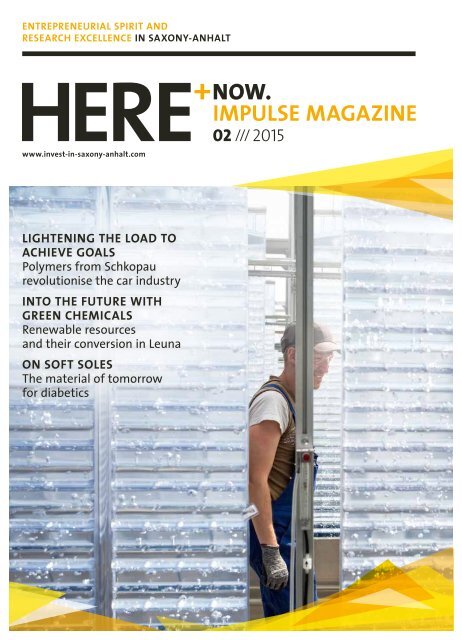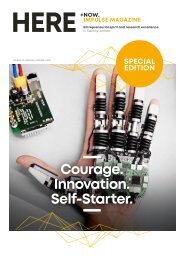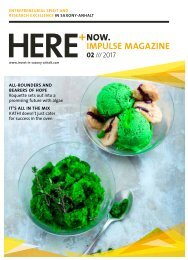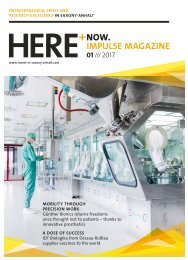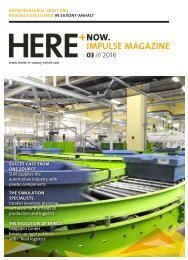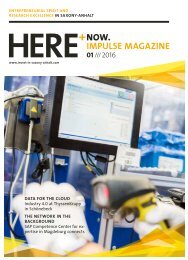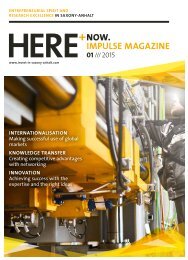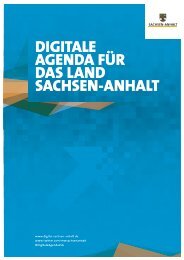HERE+NOW.IMPULSE MAGAZINE /// 02/2015
HERE is where the chemistry is right. With its Regional Innovation Strategy (RIS), Saxony-Anhalt is setting its course for the future. In this context, the lead market of Chemicals and the Bio-economy plays a special role. While the roots of the chemical industry in Saxony-Anhalt go back to the beginning of the 20th century, the bio-economy is still a relatively young development. What is undisputed, however, is the enormous potential that this relatively new sector offers to key traditional sectors such as the chemical and pharmaceutical industries, but also to energy, agriculture and forestry. In terms of new materials and materials on the basis of renewable raw materials, Saxony-Anhalt plays a pioneering role in Europe. The local BioEconomy Cluster is a leading cluster of the German Federal Ministry of Education and Research (BMBF) which has the objective of promoting and establishing complete regional value chains. The "HERE+NOW" impulse magazine would like to show you some examples of how the interplay between science and industry is creating trendsetting technologies and products. These range from new plastics that are revolutionising the automotive industry with lightweight components through to processes which convert renewable raw materials into hydrocarbons.
HERE is where the chemistry is right.
With its Regional Innovation Strategy (RIS), Saxony-Anhalt is setting its course for the future. In this context, the lead market of Chemicals and the Bio-economy plays a special role.
While the roots of the chemical industry in Saxony-Anhalt go back to the beginning of the 20th century, the bio-economy is still a relatively young development. What is undisputed, however, is the enormous potential that this relatively new sector offers to key traditional sectors such as the chemical and pharmaceutical industries, but also to energy, agriculture and forestry.
In terms of new materials and materials on the basis of renewable raw materials, Saxony-Anhalt plays a pioneering role in Europe. The local BioEconomy Cluster is a leading cluster of the German Federal Ministry of Education and Research (BMBF) which has the objective of promoting and establishing complete regional value chains.
The "HERE+NOW" impulse magazine would like to show you some examples of how the interplay between science and industry is creating trendsetting technologies and products. These range from new plastics that are revolutionising the automotive industry with lightweight components through to processes which convert renewable raw materials into hydrocarbons.
Create successful ePaper yourself
Turn your PDF publications into a flip-book with our unique Google optimized e-Paper software.
ENTREPRENEURIAL SPIRIT AND<br />
RESEARCH EXCELLENCE IN SAXONY-ANHALT<br />
HERE +NOW.<br />
<strong>IMPULSE</strong> <strong>MAGAZINE</strong><br />
<strong>02</strong> /// <strong>2015</strong><br />
www.invest-in-saxony-anhalt.com<br />
LIGHTENING THE LOAD TO<br />
ACHIEVE GOALS<br />
Polymers from Schkopau<br />
revolutionise the car industry<br />
INTO THE FUTURE WITH<br />
GREEN CHEMICALS<br />
Renewable resources<br />
and their conversion in Leuna<br />
ON SOFT SOLES<br />
The material of tomorrow<br />
for diabetics
CONTENTS<br />
1<br />
EDITORIAL<br />
MARKET OF THE FUTURE<br />
CHEMISTRY AND BIOECONOMY<br />
COVER: Algae cultivation in Leuna: renewable raw materials<br />
are converted at the Fraunhofer Centre for Chemical-Biotechnological<br />
Processes.<br />
3<br />
PROFESSION<br />
LIGHTENING THE LOAD TO<br />
ACHIEVE GOALS<br />
PAZ IN SCHKOPAU IS REVO-<br />
LUTIONISING POLYMER<br />
PROCESSING FOR THE<br />
AUTOMOTIVE INDUSTRY<br />
13<br />
START-UP<br />
BRAND NEW PERSPECTIVES<br />
6<br />
POTENTIAL<br />
INTO THE FUTURE WITH<br />
GREEN CHEMICALS<br />
17<br />
RELATION<br />
ON SOFT SOLES<br />
THE MATERIAL FOR THE<br />
DIABETIC SHOE OF<br />
TOMORROW IS FROM<br />
MAGDEBURG<br />
12<br />
F U T U R E<br />
CUT FROM A DIFFERENT<br />
CLOTH …<br />
INNOVATIONS FROM<br />
SAXONY-ANHALT<br />
19<br />
HIT EXPORT<br />
THE SWEET SCENTS FROM<br />
BITTERFELD-WOLFEN<br />
HERE<br />
THE CHEMISTRY<br />
IS RIGHT.<br />
With its Regional Innovation Strategy (RIS), Saxony-Anhalt is setting its<br />
course for the future. In this context, the lead market of Chemistry and<br />
BioEconomy plays a special role.<br />
While the roots of the chemical industry in Saxony-Anhalt go back to the beginning<br />
of the 20th century, the bio-economy is still a relatively young development.<br />
What is undisputed, however, is the enormous potential that this relatively new<br />
sector offers to key traditional sectors such as the chemical and pharmaceutical<br />
industries, but also to energy, agriculture and forestry.<br />
2<br />
14<br />
15<br />
18<br />
PRINCIPLES<br />
SUCCESS IS A MATTER OF LOCATION<br />
BREAKTHROUGH<br />
ENDURING ALL OVER THE WORLD<br />
K E Y F I G U R E S<br />
SUCCESS IN NUMBERS<br />
P O D I U M<br />
CONTACTS: EXPERTISE IN RESEARCH<br />
AND NETWORKS<br />
20<br />
21<br />
22<br />
22<br />
WAYS AND MEANS<br />
BY NO MEANS ALONE WHEN<br />
ENTERING NEW TERRITORY<br />
WINNERS<br />
INNOVATIVE SUCCESS STORIES<br />
ENCORE<br />
Publisher’s imprint<br />
In terms of new materials and materials on the basis of renewable raw materials,<br />
Saxony-Anhalt plays a pioneering role in Europe. The local BioEconomy Cluster<br />
is a leading cluster of the German Federal Ministry of Education and Research<br />
(BMBF) which has the objective of promoting and establishing complete regional<br />
value chains.<br />
The “<strong>HERE+NOW</strong>” impulse magazine would like to show you some examples of<br />
how the interplay between science and industry is creating trendsetting technologies<br />
and products. These range from new plastics that are revolutionising the<br />
automotive industry with lightweight components through to processes which<br />
convert renewable raw materials into hydrocarbons.
PRINCIPLES<br />
SUCCESS IS<br />
A MATTER OF<br />
LOCATION<br />
Dorrit Zischkale and Nico Horn are Senior<br />
Managers at the Investment and<br />
Marketing Corporation Saxony- Anhalt<br />
(IMG). A discussion about the skill and<br />
enthusiasm behind finding the right location for<br />
an investor.<br />
NICO HORN<br />
Senior Manager, Investment<br />
and Marketing Corpo ration<br />
Saxony-Anhalt (IMG)<br />
DORRIT ZISCHKALE<br />
Senior Manager, Investment<br />
and Marketing Corpo ration<br />
Saxony-Anhalt (IMG)<br />
2 3 MARKET OF THE FUTURE CHEMISTRY AND BIOECONOMY : PROFESSION<br />
LIGHTENING<br />
THE LOAD TO<br />
ACHIEVE GOALS<br />
PAZ IN SCHKOPAU IS<br />
REVOLUTIONISING POLYMER<br />
PROCESSING FOR THE<br />
AUTOMOTIVE INDUSTRY<br />
Your work involves brining companies from the<br />
area of chemicals and bio-economy to Saxony-<br />
Anhalt. How do you succeed in attracting poten tial<br />
investors?<br />
DORRIT ZISCHKALE: Unfortunately, there is no<br />
such thing as a simple form of bait, so to say. We<br />
usually receive requests that are combined with<br />
long wish lists. That’s when our work begins. We<br />
provide the investor with an offer in which we try<br />
to address all their requirements and offer solutions.<br />
NICO HORN: We are a bit like pilots who guide companies<br />
safely to their destination through what might<br />
sometimes be described as a confusing thicket. It<br />
takes experience and perseverance. It can sometimes<br />
take as long as two years from the initial enquiry to<br />
the first shovel of the spade. Also, the planned investment<br />
sums are usually different – sometimes it is<br />
two million Euros, sometimes 200 million Euros.<br />
Are there any factors which make Saxony-Anhalt<br />
particularly attractive to investors in the chemicals<br />
sector and the emerging field of the bio-economy?<br />
NICO HORN: The chemicals industry has a long tradition<br />
in Saxony-Anhalt – it is a sector in which our<br />
federal state offers considerable experience, functioning<br />
networks and highly qualified employees.<br />
In addition to this our chemical parks, such as those<br />
in Leuna, Schkopau, Zeitz and Bitterfeld-Wolfen, all<br />
feature an excellent infrastructure. As an investor,<br />
you can link up with this cluster straight away.<br />
DORRIT ZISCHKALE: The bio-economy is far from<br />
being a strictly defined field, it’s more like a cloud<br />
which floats over many industries. In recent years,<br />
intensive research has been completed into this<br />
field. The products and processes have now started<br />
to arrive on the market. The bio-economy is a topic<br />
of the future, and with our outstanding research<br />
landscape and the BioEconomy Cluster, we can<br />
offer it excellent conditions.<br />
Do you ever feel disappointed if you make a lot of<br />
effort and make a great offer, only for the investor<br />
to go somewhere else?<br />
NICO HORN: The competition is considerable. Investors<br />
look at locations all over the world. On average,<br />
for every 100 potential investors we contact, just one<br />
leads to success. Yet because we never know who<br />
that one investor will be, we always give our best.<br />
DORRIT ZISCHKALE: Our job isn’t just about bringing<br />
investors to Saxony-Anhalt. We also continue to<br />
nurture the businesses which choose to settle here.<br />
With our team of more than 40 members of staff, in<br />
our role as the federal state’s Investment and Marketing<br />
Corporation, we support companies with<br />
their relocation here, help to them organise events<br />
such as appearances at trade fairs, and bring businesses<br />
together with the universities and institutes<br />
in the federal state.<br />
www.invest-in-saxony-anhalt.com<br />
At the Fraunhofer Institute for Applied Polymer<br />
Research (PAZ) in Schkopau, the key focus is on<br />
polymer processing.
PROFESSION : MARKET OF THE FUTURE CHEMISTRY AND BIOECONOMY<br />
4 5 PROFESSION<br />
Prof. Peter Michel wants to make<br />
motor vehicles lighter.<br />
New fibre composites are put to the test for the<br />
optimum material attributes.<br />
If things progress as Professor Peter Michel expects, when<br />
it comes to cars, pretty soon the term “sheet metal damage”<br />
will no longer be used. Together with his team at the<br />
Fraunhofer Institute for Applied Polymer Research (PAZ) in<br />
Schkopau, he develops plastics for the automotive industry.<br />
The background to the polymer applications is nothing<br />
less than solving one of the most pressing problems of our<br />
time – reducing CO 2<br />
emissions.<br />
“TO COMPLY WITH THE GOAL OF<br />
THE UNITED NATIONS CLIMATE<br />
CONFERENCE to limit global<br />
warming to two degrees Celsius,<br />
it is necessary for the car<br />
industry to make its contribution,”<br />
explains Prof. Michel. To be able<br />
to signi ficantly reduce emissions<br />
by motor vehicles, a variety of<br />
parameters apply: the drive<br />
technology, the vehicle weight<br />
and the rolling resistance of the<br />
tyres. The Fraunhofer team in<br />
Schkopau have started by looking<br />
at the best ways of reducing the<br />
weight and optimising the tyres.<br />
When it comes to weight optimisations,<br />
replacing the heavy<br />
metal parts in vehicles requires<br />
exceptionally strong lightweight<br />
structures. Although significantly<br />
lower in weight, the plastic components<br />
still need to have, at the<br />
very least, the same attributes as<br />
the conventional parts. Currently,<br />
the proportion of plastic used<br />
in the support structures of an<br />
average motor vehicle is only<br />
around three percent. “This value<br />
needs to increase significantly.<br />
I believe it to be realistic that in<br />
a few years’ time, around 40%<br />
of the frame of a medium-sized<br />
car will be made from polymer<br />
components, making it around<br />
130 kilograms lighter,” explains<br />
Peter Michel. The potential of<br />
polymer applications can be illustrated<br />
by an example: in the steel<br />
version, the front-end support<br />
of a premium vehicle weighs 3.8<br />
kilograms. The plastic solution<br />
which is now used weighs just<br />
1.3 kilograms – and it’s just as<br />
strong. Car tyres need to have<br />
the lowest possible rolling resistance,<br />
a high degree of abrasion<br />
resistance and a good wet grip.<br />
Another application for which<br />
optimum elastomer-nanoparticle<br />
composites are being developed<br />
in Schkopau.<br />
OF INCREASING IMPORTANCE<br />
in polymer processing are the<br />
so-called bio-based fibre composites<br />
with flax, wood or hemp,<br />
which contribute to resource<br />
efficiency and sustainability. In<br />
addition to the composition of<br />
the material, the knowledge surrounding<br />
the properties of the<br />
components is also becoming<br />
increasingly transparent. Under<br />
the banner of the “Industry 4.0”,<br />
all the information about the<br />
material properties along the<br />
value chain is being precisely<br />
documented.<br />
THE INSTITUTE IN SCHKOPAU is<br />
an innovation motor for Central<br />
Germany that has the goal of<br />
making the manufacturing of<br />
lightweight materials suitable for<br />
mass production. “We are the interface<br />
between the chemical and<br />
automotive industries. Our goal is<br />
to turn the results of the applied<br />
research into new products and<br />
processes more quickly. We are<br />
also focusing on small and medium-sized<br />
companies in our region<br />
who can benefit from the fullscale<br />
added value in Saxony-Anhalt,”<br />
highlights Prof. Michel. The<br />
collaboration between the<br />
automotive industry and the<br />
Fraunhofer team is exceptionally<br />
close and purposeful. In this respect,<br />
one of the key advantages is the<br />
proximity to the automotive<br />
manufacturing plants in Leipzig,<br />
Wolfsburg, Zwickau and Eisenach.<br />
www.iwm.fraunhofer.de/en<br />
www.polymer-pilotanlagen.de<br />
FACTS<br />
A MODEL REGION FOR<br />
THE BIO-ECONOMY:<br />
NEW MATERIALS AND<br />
CUTTING-EDGE RESEARCH<br />
Saxony-Anhalt is currently home<br />
to some 100 stakeholders in the<br />
areas of industry and research<br />
who work in 45 joint projects<br />
that are funded by the German<br />
Federal Ministry of Education and<br />
Research. With a total budget<br />
of some 80 million Euros, their<br />
key focus is on the development<br />
of resource-efficient construction<br />
materials and lightweight<br />
construction materials, bio-based<br />
chemicals and plastics, highperformance<br />
composites and the<br />
production of bioenergy.
POTENTIAL<br />
6 7 POTENTIAL<br />
INTO THE FUTURE WITH<br />
GREEN CHEMICALS<br />
PROCESSES FOR THE CONVERSION OF<br />
RENEWABLE RAW MATERIALS ARE BEING<br />
DEVELOPED IN LEUNA<br />
Before they are used in the industry, chemical and<br />
biotechnical systems in Leuna are put to test on a<br />
smaller scale basis.
POTENTIAL : MARKET OF THE FUTURE CHEMISTRY AND BIOECONOMY<br />
8 9 POTENTIAL<br />
A CHEMICALS REGION<br />
TAKES ON THE RAW<br />
MATERIALS TRANSITION<br />
AN INTERVIEW WITH HORST MOSLER,<br />
CLUSTER MANAGER OF THE BIOECONOMY CLUSTER<br />
The problem has been well-known for many years: global<br />
oil reserves are running out. Replacements for the versatile<br />
and sought-after raw material were not in sight for a<br />
long time. At the Leuna Chemical Park, however, a solution<br />
to this problem is now very much on track. The company<br />
Global Bioenergies GmbH and the Fraunhofer Centre for<br />
Chemical-Biotechnological Processes (CBP) are working on<br />
a demonstration system which converts renewable raw<br />
materials into isobutene – a hydrocarbon mixed into fuel.<br />
From beech wood chippings<br />
through to algae – renewable<br />
resources have a great future.<br />
GERD UNKELBACH AND ALES<br />
BULC are still standing in a<br />
lar gely empty hall. The Director<br />
of the Fraunhofer Centre and the<br />
Manager of Global Bioenergies<br />
are in a state of anticipation. If all<br />
goes well, by November <strong>2015</strong> the<br />
waiting will finally be over: the<br />
installation of the pilot system<br />
will begin. Following its commissioning,<br />
which will be completed<br />
in mid-2016, it will become clear<br />
as to whether the conversion<br />
process developed by Global Bioenergies<br />
also works on an industrial<br />
scale. This is an important<br />
step in finding investors for the<br />
new technology. “Since laboratory<br />
results aren’t usually<br />
enough for potential investors,<br />
it is necessary to construct<br />
a system which also delivers<br />
meaningful results for the world<br />
of industry. In this way, we can<br />
close the gap between the laboratory<br />
and the industrial realisation,”<br />
explains chemist Gerd<br />
Unkelbach.<br />
THE DECISION by Global Bioenergies<br />
to test its pilot system<br />
with the Fraunhofer CBP wasn’t<br />
simply a matter of course. In addition<br />
to the Fraunhofer CBP, over<br />
100 competitors around the world<br />
would also have been pleased to<br />
cooperate with the biotechnology<br />
company Global Bioenergies,<br />
which specialises in gas fermentation.<br />
“We didn’t just choose<br />
Leuna because of its excellent<br />
infrastructure, but also because<br />
of the skilled workers for our area<br />
of business and the additional<br />
companies with experience in<br />
the bio-economy sector nearby.<br />
In addition to this, there is also a<br />
widespread sense of acceptance<br />
for the chemical industry in the<br />
region. Before we finally decided<br />
on Leuna, in the final round, we<br />
also considered two locations<br />
outside Europe,” explains Ales<br />
Bulc of Global Bioenergies.<br />
What makes Saxony-Anhalt attractive<br />
for the bio-economy?<br />
HORST MOSLER: With a long tradition in chemicals,<br />
an established network for chemicals and plastics<br />
and five high-performance chemical parks, chemicals<br />
are one of the mainstays of Saxony-Anhalt's economy.<br />
Before the backdrop of climate change and finite<br />
fossil fuel resources, over the decades to come, the<br />
chemicals sector will be facing a comprehensive transition<br />
in the area of raw materials. As the European<br />
pioneer in this field, Saxony-Anhalt is excellently<br />
prepared for this. Its Regional Innovation Strategy<br />
with the lead market of “Chemicals and Bio-economy”<br />
has provided the strategic basis, and the local<br />
headquarters of the leading-edge cluster as well<br />
as the excellent research centres and the pilot and<br />
demonstration systems for the processing of biobased<br />
raw materials at the biggest chemical location<br />
by area in Germany – Leuna Chemical Park – provide<br />
the infrastructure.<br />
How do you assess the current development of<br />
the bio-economy in the federal state?<br />
HORST MOSLER: We are very pleased that following<br />
the establishment of the Fraunhofer Center for<br />
Chemical-Biotechnological Processes CBP, the pilot<br />
system for green hydrogen by Linde and the multi-purpose<br />
fermentation plant by Thyssen-Krupp,<br />
that with leading-edge cluster project by technological<br />
leader Global Bioenergies, another standout<br />
project is now coming to fruition at the Leuna<br />
site. In this way, the raw materials transition in the<br />
chemical region is being driven forwards pro-actively<br />
and integrated into existing structures. Saxony-<br />
Anhalt has become an attractive investment location<br />
for bio-based production processes and offers<br />
considerable further development potential for<br />
businesses due to its links with innovative network<br />
structures such as the BioEconomy Cluster.<br />
What are the advantages<br />
of collaborating in the cluster?<br />
HORST MOSLER: For small and medium-sized businesses<br />
in particular, the research and development<br />
network allows innovation processes to be accelerated<br />
– as this is where the sector-spanning exchange<br />
of know-how that is so important to the bio-economy<br />
takes place. In addition to this, collaborating in<br />
the network also brings potential cooperation partners<br />
together, so that many individual efforts create<br />
competitive value-added chains. In cooperation with<br />
the European, national and regional policy-makers as<br />
well as further cluster stakeholders, the bridge over<br />
the proverbial “Valley of Death” is crossed, i.e. the<br />
financing of product developments from the laboratory<br />
into the market. Finally, in the stakeholders in<br />
the bio-economy such as the agricultural and forestry<br />
sectors, which are also strong in Saxony-Anhalt,<br />
and the chemical industry, which have not previously<br />
collaborated, are also brought together. In this<br />
way, collaborating in the cluster also supports the<br />
exploitation and development of areas of business<br />
relating to the bio-economy, as the entire knowhow<br />
of the cluster can be put to use. For businesses<br />
in Saxony-Anhalt, this means, on the one hand, the<br />
opportunity to step into a forward-looking market<br />
as part of an effective network at an early stage,<br />
and on the other hand, to work towards ensuring<br />
a sustainable future on the basis of renewable raw<br />
materials.<br />
en.bioeconomy.de<br />
HORST MOSLER<br />
Cluster Manager of the<br />
BioEconomy Cluster
POTENTIAL : MARKET OF THE FUTURE CHEMISTRY AND BIOECONOMY<br />
10 11 POTENTIAL<br />
REQUESTED ...<br />
REQUESTED ...<br />
GERD UNKELBACH<br />
Director of the<br />
Fraunhofer CBP<br />
ALES BULC<br />
Manager at Global<br />
Bioenergies GmbH<br />
At the Fraunhofer CBP in Leuna, energy and<br />
resource-efficient processes are developed<br />
and tested.<br />
“We are very<br />
pleased to<br />
be taking part in<br />
the development<br />
of this sustainable<br />
manufacturing<br />
process. The project<br />
is ideally suited to<br />
the infrastructure<br />
and research area of<br />
the CBP. In the scope<br />
of our collaboration,<br />
we are supporting<br />
Global Bioenergies<br />
with our know-how<br />
in the area of the<br />
further development<br />
of biotechnology and<br />
chemical processes.”<br />
THE SYSTEM, which is a world's<br />
first, is now under construction<br />
in Leuna. The demonstration<br />
system will produce high-purity<br />
isobutene with the use of micro-organisms<br />
which can be used<br />
for the production of plastics and<br />
elastomers, as well as for biofuels<br />
such as iso-octane. Its production<br />
capacity of 100 tonnes per year<br />
enables these raw materials to<br />
be made available to interested<br />
industrial companies for testing<br />
purposes. The car manufacturer<br />
Audi, for example, has already<br />
signed up to a partnership. The<br />
Fraunhofer CBP has experience<br />
tioning, the Fraunhofer Center in<br />
Leuna does everything under one<br />
roof. With this flexible concept,<br />
raw materials such as vegetable<br />
oils, cellulose, starch and sugar<br />
can be prepared and converted<br />
into chemical products. “For<br />
small and medium-sized companies<br />
in particular, we offer excellent<br />
opportunities for scaling up<br />
new technologies,” explains Gerd<br />
Unkelbach. The objective of the<br />
engineers and chemists is to develop<br />
processes and production<br />
networks which are as energy<br />
and resource-efficient as possible.<br />
This minimises waste flows,<br />
with pilot systems. In addition<br />
to its cooperation with Global<br />
Bioenergies, the centre in Leuna<br />
works together with partners<br />
from industry, with universities<br />
and with other research organisations.<br />
Their common concern is<br />
always the realisation of products<br />
on the basis of renewable raw<br />
materials. In this respect, the<br />
Fraunhofer CBP also experiments<br />
with green and brown algae as<br />
well as with waste beech wood<br />
chippings from sawmills. From<br />
the preparation of raw materials,<br />
to biotechnological and chemical<br />
processes, to product recondimakes<br />
use of raw materials<br />
which are unsuitable for the<br />
production food and feed, and<br />
reduces carbon dioxide emissions.<br />
www.cbp.fraunhofer.de/en<br />
www.global-bioenergies.com<br />
“The pilot system<br />
is another important<br />
step forwards in<br />
the development of the<br />
isobutene process from<br />
being a ground-breaking<br />
scientific innovation to a<br />
high-grade industrial process.<br />
In Leuna, we have<br />
first-rate partners for the<br />
commissioning and operation<br />
of this pilot system.<br />
Our cooperation with<br />
the Fraunhofer CBP has<br />
proven exceptionally<br />
worthwhile for us, so<br />
much so that we are<br />
already considering embarking<br />
on further shared<br />
projects with them.”
FUTURE : MARKET OF THE FUTURE CHEMISTRY AND BIOECONOMY<br />
12 13<br />
MARKET OF THE FUTURE CHEMISTRY AND BIOECONOMY : START-UP<br />
CUT FROM A DIFFERENT CLOTH …<br />
INNOVATIONS FROM SAXONY-ANHALT<br />
BRAND NEW PERSPECTIVES:<br />
START-UPS FROM SAXONY-ANHALT<br />
LAGOTEC GMBH | www.lagotec.de<br />
Dirty pipelines don’t pose a problem: effective chemicals clear the way. Special sensors from<br />
Lagotec determine the maximum amount of chemicals required.<br />
Effectiveness isn’t necessarily the same as strength. Chemicals are effective but they can be harmful<br />
at the same time. The biofilm sensors from the Magdeburg company LAGOTEC GmbH measure the<br />
transfer of heat in pipelines and containers. In this way, the smallest deposits in the water cycle are<br />
detected and can be targeted. The precise dosage of the necessary chemicals protects both the environment<br />
and the wallet. Power plants, paper mills and food producers all over Europe swear by it.<br />
TIMURA HOLZMANUFAKTUR GMBH | www.timura.de<br />
“Tropical wood that’s made in Germany” – is there such a thing? The company timura Holzmanufaktur<br />
GmbH which is situated in the Harz region thermally refines wood and therefore<br />
offers environmentally-friendly alternatives in fine colours.<br />
Timura has patented a very special vacuum-press drying process. In this process, on a gentle basis,<br />
native species of wood such as ash or oak are thermally refined in a vacuum chamber. The process<br />
is especially economical because it doesn’t require the entire chamber to be heated. Harmful substances<br />
from the wood evaporate, making it the only thermal wood in the world that can be safely<br />
used indoors: easy-care, high-quality wood for floors and facades.<br />
C 3 TECHNOLOGIES GMBH | www.c3tec.de<br />
Stable and cost-effective construction without crude oil and high-energy processes: the<br />
company C3 Technologies GmbH from Halle (Saale) manufactures environmentally-friendly<br />
high-tech composite materials from renewable raw materials in the region.<br />
The innovative construction components and systems can be used for the expansion and insulation<br />
of buildings, for the production of modular rapid construction systems as well as in the field of trade<br />
fair and shop construction. Natural fibres, resin systems and hard foam provide the basis for laminates,<br />
panels and construction elements. The sustainable materials have been developed in a joint<br />
research project with the Fraunhofer Institute for Microstructure of Materials and Systems IMWS in<br />
Halle (Saale). In the future, the elements are set to consist exclusively of renewable raw materials.<br />
INL GMBH<br />
INL GmbH advises farmers on<br />
sustainable forms of cultivation.<br />
Some ideas make the world appear in a different<br />
light. In 2008, the company boraident GmbH<br />
relaunched itself – with plenty of ideas<br />
surroun ding the well-known material of glass.<br />
The company is looking for new areas of application.<br />
One of them: the protection of birds.<br />
“Laserbird” is the name of the system that makes<br />
windows visible to birds with a special coating.<br />
For people, however, the life-saving layer remains<br />
invisible. The idea has already been awarded with<br />
the IQ Innovation Award of the City of Halle (Saale).<br />
Boraident GmbH also specialises in incorporating<br />
nanoparticles into glass. For this purpose, the company<br />
uses precision lasers and can mark ampoules<br />
with a code, for instance. This allows the production<br />
of medical drugs to become transparent. |<br />
www.boraident.de<br />
The demand for sustainably produced food is<br />
increasing, but the greater demand is being<br />
offset by enormous cost pressure. It is at this<br />
interface that the company INL GmbH is working<br />
to ensure that customers can benefit from<br />
safety, and farmers have a lesser workload.<br />
What is the best way to dose fertilizers? What points<br />
of reference can help assess vegetable farming? The<br />
Private Institute for Sustainable Land Cultivation<br />
(INL) is looking for solutions. INL GmbH was founded<br />
in May 2009 and now has eleven members of staff.<br />
It advises agricultural businesses, service providers<br />
and authorities, prepares studies as well as concepts,<br />
and helps with the development of management<br />
systems. Its key focal topics include crop cultivation,<br />
soil quality and animal husbandry. |<br />
www.nachhaltige-landbewirtschaftung.de<br />
BORAIDENT GMBH<br />
A special coating protects windows<br />
from being struck by birds.
BREAKTHROUGH : MARKET OF THE FUTURE CHEMISTRY AND BIOECONOMY<br />
14 15<br />
MARKET OF THE FUTURE CHEMISTRY AND BIOECONOMY : KEY FIGURES<br />
ENDURING ALL OVER THE WORLD:<br />
TECHNOLOGY FROM SAXONY-ANHALT<br />
NOVO-TECH GMBH & CO. KG /<br />
MEGAWOOD<br />
Polymer-wood-flooring is particularly<br />
advantageous outdoors.<br />
When it comes to patio floors, many people<br />
swear by wood. And wood can be made even<br />
more beautiful: just as natural in feeling, just<br />
as easy to work with, but less sensitive. Novo-<br />
Tech has been selling its popular “Megawood”<br />
flooring since 2007.<br />
Barefoot flooring and premium flooring are the<br />
names given by Novo-Tech GmbH & Co. KG to their<br />
patented products. The company from Aschersleben<br />
is the European market leader for polymer-bound<br />
wood-based materials. These recyclable natural<br />
products are sold worldwide, and thanks to their<br />
surface hardness, they are easy to install outdoors,<br />
even in Australia and Siberia. The company, which<br />
now has more than 100 employees, also offers<br />
solutions for privacy screens and floor spotlights. |<br />
www.megawood.com<br />
SUCCESS IN<br />
NUMBERS:<br />
DID YOU<br />
KNOW?<br />
The basic idea<br />
behind the chemical<br />
park originated in<br />
Saxony-Anhalt in the<br />
1990s.<br />
16.9 %<br />
(EUR 6.1 bn.) of the total industrial turnover in the<br />
federal state of Saxony-Anhalt is generated by the<br />
chemicals industry.<br />
the lightest HGV seat in<br />
the world weighs just<br />
kg<br />
(IFA Technologies Haldensleben).<br />
The oldest synthetic material<br />
from Ventral Germany is<br />
Production of<br />
chemical products in<br />
the last ten years:<br />
growth in turnover<br />
+ 63.4 %<br />
employees<br />
+ 40.4 %<br />
<strong>2015</strong> should be their year of breakthrough:<br />
after five years, the two chemists Monika<br />
Lelonek and Petra Göring want to make their<br />
way without subsidies. Their company Smart-<br />
Membranes sells its high-quality extremely<br />
fine and symmetrical worldwide.<br />
The products of SmartMembranes GmbH are so<br />
precise that they are able to separate particles and<br />
filter liquids in the nanometre range. In an electrochemical<br />
etching process, air pores are generated<br />
in aluminium oxide or silicone, all of which have the<br />
same spacing. Word of this world’s first had to get<br />
around first when the two women from the Martin<br />
Luther University Halle and the Fraunhofer Institute<br />
for Microstructure of Materials and Systems IMWS<br />
entered into their collaboration. They have now set<br />
themselves up with four employees in a niche market.<br />
| www.smartmembranes.de/en<br />
SMARTMEMBRANES GMBH<br />
Successful founders:<br />
Monika Lelonek (l.) and Petra<br />
Göring.<br />
years old –<br />
it was found in Königsaue near<br />
Aschersleben.<br />
Approximately<br />
million cubic<br />
metres: the total<br />
annual demand<br />
in the wood<br />
processing industry.<br />
The leading-edge BioEconomy<br />
Cluster has<br />
members and<br />
project partners,<br />
53 of which are small and<br />
medium-sized companies<br />
(as of the end of 2014).<br />
11,897<br />
In <strong>2015</strong>, some<br />
were employed in the chemicals sector here.<br />
On average, each employee generated<br />
516,581 EUR in turnover.
PODIUM : MARKET OF THE FUTURE CHEMISTRY AND BIOECONOMY<br />
CONTACTS:<br />
EXPERTISE IN RESEARCH AND NETWORKS<br />
UNIVERSITIES<br />
AND NON-<br />
UNIVERSITY<br />
RESEARCH<br />
ORGANISATIONS<br />
Martin Luther University Halle-Wittenberg (MLU), Chair for<br />
Plastics Technology, Faculty of Natural Sciences I and III<br />
Otto von Guericke University Magdeburg (OvGU), Faculty of<br />
Process and Systems Engineering, Institute for Systems and<br />
Environmental Technology, Faculty of Mechanical Engineering<br />
www.kunststofftechnik.uni-halle.de;<br />
www.natfak1.uni-halle.de;<br />
www.natfak3.uni-halle.de<br />
www.vst.ovgu.de;<br />
www.fvst.ovgu.de/iaut.html;<br />
www.fmb.ovgu.de<br />
16 17<br />
ON SOFT SOLES<br />
THE MATERIAL FOR THE DIABETIC SHOE<br />
OF TOMORROW IS FROM MAGDEBURG<br />
RELATION<br />
Fraunhofer Institute for the Microstructure of Active Agents<br />
and Systems IMWS<br />
Max Planck Institute for Dynamic Complex Technical<br />
Systems, Magdeburg<br />
Merseburg University of Applied Sciences, Department of<br />
Engineering and Natural Sciences<br />
Anhalt University of Applied Sciences<br />
Magdeburg-Stendal University of Applied Sciences,<br />
Institute for Mechanical Engineering<br />
Leibniz Institute for Plant Biochemistry IPB, Halle<br />
www.iwm.fraunhofer.de<br />
www.mpi-magdeburg.mpg.de<br />
www.hs-merseburg.de/<br />
inw/aktuelles/<br />
www.hs-anhalt.de<br />
www.hs-magdeburg.de/<br />
hochschule/fachbereiche/iwid/<br />
institut-fuer-maschinenbau.html<br />
www.ipb-halle.de<br />
TRANSFER<br />
AND RESEARCH<br />
CENTRES<br />
Fraunhofer Institute for Applied Polymer Research, PAZ<br />
Fraunhofer Centre for Biotechnolog. Processes, CBP<br />
www.iap.fraunhofer.de/de/<br />
Forschungsbereiche/Pilotanlagenzentrum_Schkopau<br />
www.cbp.fraunhofer.de<br />
Biocentre Halle<br />
KAT Competence Centre for Natural Sciences, Chemicals/Plastics<br />
Polymer Competence Centre KKZ Halle-Merseburg<br />
ppm Pilot Centre for Vegetable Oil Technology Magdeburg e. V.,<br />
Pilot Systems Centre for Plant Technology and Protein Synthesis<br />
www.biozentrum.uni-halle.de<br />
kat.hs-harz.de/index.php?id=63<br />
www.kkz-halle-merseburg.de<br />
www.ppm-magdeburg.de<br />
Helmholtz Centre for Environmental Research GmbH, UFZ, Leipzig-Halle www.ufz.de<br />
Leibniz ScienceCampus Halle, Plant-based Bio-economy<br />
www.sciencecampus-halle.de<br />
ZSG Zeitzer Standortgesellschaft mbH<br />
www.industriepark-zeitz.com<br />
Chemical Park Bitterfeld-Wolfen GmbH<br />
InfraLeuna GmbH<br />
Dow Olefinverbund GmbH Schkopau<br />
www.chemiepark.de<br />
www.infraleuna.de<br />
www.dow.com/valuepark<br />
CLUSTERS<br />
AND<br />
NETWORKS<br />
Polymer Synthesis and Polymer Processing Saxony-Anhalt<br />
Automotive Cluster Saxony-Anhalt<br />
Chemical/Plastics Central Germany (state-spanning)<br />
Biotechnology in Sachsen-Anhalt<br />
BioEconomy Cluster<br />
ELISA – Electric Mobility and Lightweight Constructions in Saxony–Anhalt<br />
www.polykum.de<br />
www.mahreg.de<br />
www.cluster-chemie-kunststoffe.de<br />
www.bmdlifesciences.de (BMD)<br />
www.bioeconomy.de<br />
www.elisa-cluster.de<br />
Help for millions of patients:<br />
Dr. Peter Gerth of the KAT<br />
Competence Centre develops<br />
soles for diabetics.
RELATION<br />
A special plastic compound makes<br />
the soles particularly soft.<br />
KAT Competence Centre at Magdeburg-Stendal<br />
University of Applied Sciences. In German, KAT is<br />
short for “competence network for applied and<br />
transfer-oriented research”. Magdeburg specialises<br />
in engineering/renewable resources. Together with<br />
their international partners, the experts for natural<br />
fibre reinforced composites have already developed<br />
an innovative running shoe. With their DiaBSmart<br />
project, they are now researching the right kind of<br />
plastic for specialist, individualised shoe soles for<br />
diabetics.<br />
18 19 HIT EXPORT<br />
THE SWEET<br />
SCENTS FROM<br />
BITTERFELD-WOLFEN<br />
“It’s something that can only be achieved with<br />
chemicals,” explains Dr. Peter Gerth, meaning the<br />
search for the right mix. Yet behind the DiaBSmart<br />
project is an extensive network of international<br />
partners. Together they are fighting the complications<br />
of a disease which is on the rise worldwide:<br />
diabetes mellitus.<br />
“50% OF ALL LOWER LIMB AMPUTATIONS are<br />
caused by diabetes," explains Dr. Peter Gerth,<br />
discussing the problematic consequential symptoms.<br />
Patients are injured because they literally can’t tell<br />
where the shoe pinches due to their damaged nerves.<br />
In addition to this, as the disease progresses, the<br />
tissue of the feet becomes increasingly vulnerable.<br />
SPECIAL FOOTWEAR should prevent this. “The<br />
shoes available on the market are far from optimal,<br />
however,” says Gerth. Gerth is spokesman of the<br />
FACTS<br />
SOME 194 MILLION PEOPLE are<br />
diagnosed with diabetes worldwide.<br />
By 2<strong>02</strong>5 this number is<br />
expected to reach 334 million.<br />
IT WAS AN ENTRY in the Enterprise<br />
Europe Network (EEN) that caused<br />
the international partners to come<br />
together and develop a new running<br />
shoe: een.ec.europa.eu<br />
Staffordshire University in England has used a new<br />
measuring method to determine the condition<br />
of the patient's foot and the attributes that their<br />
personal shoe sole should have. On the basis of<br />
this data, Romanian chemist Dr. Iulian Nor and his<br />
team in Magdeburg have spent a year and a half<br />
researching the right recipe for the plastic. In this<br />
respect, attributes such as the degree of hardness,<br />
rebound elasticity and durability all have a role.<br />
THE TEAM IN MAGDEBURG sends its sample<br />
products to Dr. A. Ramachandran's diabetes<br />
hospital in Chennai, India. It is there that they are<br />
adapted to the patients’ feet and clinically tested.<br />
The new diabetic soles may be ready for their<br />
market launch as soon as 2017. In this respect,<br />
additional cooperation partners have already<br />
come into play: the companies Saltstechstep<br />
and Technofootbed SL from the United Kingdom<br />
and Spain have been involved, seconding staff,<br />
for several months. They could soon be the first<br />
manufacturers and serve the European market.<br />
COMPANIES CAN AWARD RESEARCH<br />
CONTRACTS through the KAT Competence<br />
Network in Saxony-Anhalt. Each<br />
university has its own special focus:<br />
www.kat-netzwerk.de<br />
Amber, violet, grapefruit: a world of fragrances.<br />
And they are also delivered all over the world.<br />
Chemical company Miltitz Aromatics GmbH has<br />
some 100 customers in 27 different countries.<br />
It manufactures synthetic fragrances scents for<br />
both perfume and detergent manufacturers<br />
and for the food industry.<br />
THE GERMAN WORD FOR MILDEW IS “SCHIMMEL”,<br />
something that isn’t exactly associated with<br />
plea sant fragrances. Yet Schimmel was once the<br />
name of a respected company for fragrances and<br />
flavourings which was founded in the town of<br />
Miltitz near Leipzig in 1829, before becoming part of<br />
Miltitz chemical plant in the GDR-era. In the 1990s,<br />
when everything seemed dead and buried, a brave<br />
man decided to make a fresh start. In 1992, chemist<br />
Dr. Peter Müller founded Miltitz Aromatics GmbH<br />
together with four other shareholders – building on<br />
the success of the erstwhile company Schimmel.<br />
THE NEW COMPANY, which chose to settle in<br />
Bitterfeld-Wolfen due to the excellent local<br />
In the laboratory of Miltitz Aromatics,<br />
the staff continuously tinker with new<br />
fragrances.<br />
infrastructure, started life with just four customers,<br />
but already had an international focus. Its initial<br />
large-scale order came from the French town of<br />
Grasse, which is considered to be the world capital<br />
of perfume. The order consisted of a contract<br />
for the production of a violet fragrance. Miltitz<br />
Aromatics GmbH continues to offer contract<br />
manufacturing services to this day. It is also home<br />
to a major research department: almost half of its<br />
50 employees work on finding the right formulas<br />
for fulfilling every customer need. “Our portfolio<br />
consists of approximately 100 products that are the<br />
result of refined chemicals processes,” explains Dr.<br />
Stefan Müller, the son and successor of previous<br />
Managing Director Peter Müller. He highlights<br />
isoprene and specific hydrogenation products in the<br />
50 to 250 TPY range. "We exclusively manufacture<br />
the product Hydroxy ambran worldwide" – he<br />
is talking about Ambra, a tobacco-like, woody<br />
fragrance which is originally from sperm whales.<br />
www.miltitz-aromatics.com/en
WAYS AND MEANS 20<br />
21<br />
WINNERS<br />
RENO PAUL<br />
Group Leader for Technology Funding<br />
Programmes at the Investment Bank<br />
Saxony-Anhalt<br />
INNOVATIVE SUCCESS STORIES<br />
BY NO MEANS ALONE<br />
WHEN ENTERING<br />
NEW TERRITORY<br />
3 RD PLACE IN THE BESTFORM AWARD <strong>2015</strong><br />
CAROLIN SCHULZE AND INSECT FARM L. SEITZ<br />
TOPIC: Pretend rabbit / Bugs Bunny<br />
The problems surrounding meat production may be well-known, but the demand<br />
for animal protein continues. Carolin Schulze, an industrial design student<br />
at the University of Art and Design Halle, and the insect farm L. Seitz have come<br />
up with a new way of satisfying the hunger of the world with a 3D printer: in<br />
the form of “pretend rabbits” made from mealworms. Great value for money!<br />
www.freyhaendig.de<br />
“No business is too small for innovations.” The<br />
Investment Bank Saxony-Anhalt follows up<br />
the words of Minister for Economic Affairs Hartmut<br />
Möllring with actions: with an extensive offering of<br />
financial support, it is once again providing funding<br />
to small and medium-sized companies that want to<br />
enter new territory. Reno Paul explains the possibilities.<br />
What does the word “innovation” mean in the<br />
“language of financial support”?<br />
RENO PAUL: It isn't complicated. The Investment<br />
Bank supports research and development projects<br />
as well as projects in the transfer of knowledge and<br />
technology. It is frequently the case that smaller<br />
companies don’t have sufficient capacity to break<br />
new ground on their own. We provide small and medium-sized<br />
businesses with financial support – and<br />
explain the required processes to them.<br />
How is this support configured exactly?<br />
RENO PAUL: We can provide support to the development<br />
of innovative products and processes, for<br />
example. Projects are eligible for subsidies of up<br />
to 80 percent, with a maximum of 400,000 Euros<br />
being available. The Innovation Assistant, in turn,<br />
provides grants for personnel costs with appointments<br />
of graduates who are fresh out of university.<br />
Consulting and advice services can point the way<br />
to new goals and are therefore eligible for funding<br />
as part of the Knowledge and Technology Transfer<br />
Programme. The range of options is so varied that I<br />
can only touch on a few examples.<br />
What things are new this year?<br />
RENO PAUL: Research and knowledge-based organisations<br />
are eligible for support of up to 100 percent<br />
for projects in the non-economic sphere. In addition<br />
to this, our funding for patents has also been adapted.<br />
In this respect, in the scope of R&D projects, small<br />
and medium-sized companies and handicraft businesses<br />
are eligible for up to 25,000 Euros to enable<br />
them to protect their innovations.<br />
These days, the Innovation Assistant also supports<br />
the hiring of university graduates from the creative<br />
sciences. This is because they provide fresh ideas in<br />
the areas of marketing as well as product and market<br />
launches.<br />
So companies in Saxony-Anhalt aren’t alone?<br />
RENO PAUL: No, they aren’t. After all, we all benefit<br />
from the risks that they take. Incidentally, the Investment<br />
Bank can also provide help when several partners<br />
come together for a project, whether it is different<br />
companies or a business and a university, for instance.<br />
WINNER OF THE AURA 2013<br />
ACKERMANN FAHRZEUGBAU OSCHERSLEBEN GMBH<br />
TOPIC: Development of a very lightweight HGV trailer<br />
The company Ackermann Fahrzeugbau Oschersleben GmbH is the third winner<br />
of the AURA prize, which is conferred by the federal state for outstanding<br />
entrepreneurial achievements in Saxony-Anhalt. In 2013, Ackermann Fahrzeugbau<br />
was honoured due to its intensive cooperation with the University<br />
of Applied Sciences Magdeburg-Stendal over the course of several years.<br />
www.ackermann-trailers.com<br />
3 RD PLACE IN THE HUGO JUNKERS PRIZE 2014<br />
EXIPNOS GMBH<br />
TOPIC: Most innovative product development<br />
With its “Direct Compounding Injection Moulding (DCIM)”, the Merseburg<br />
company Exipnos GmbH is revolutionising the production of plastic blends:<br />
its process enables the compounding to take place directly in the injection<br />
moulding machine, i. e. to introduce additives so as to obtain the desired<br />
composite material. It was previously necessary to complete this process<br />
before the injection moulding.<br />
www.exipnos.de
ENCORE<br />
ATTRACTIVE:<br />
Saxony-Anhalt’s moderate<br />
cost structure ensures competitive<br />
advantages for every<br />
investor: At approx. 13 Euros<br />
the average price per square<br />
metre for a fully developed<br />
industrial zone is substantially<br />
below the German average.<br />
The rate of funding that is<br />
available to support wage<br />
costs amounts to up to 10%<br />
of the specified wage costs.<br />
OPTIMAL:<br />
Saxony-Anhalt has the highest<br />
funding rates in Germany. Small<br />
companies are funded up to<br />
30%, medium-sized ones up to<br />
20% and large ones up to 10%.<br />
FAST:<br />
The IMG acts as a one-stop<br />
agency; fast decision-making<br />
channels and realisation periods<br />
will facilitate your market entry<br />
in Saxony-Anhalt.<br />
2,000 KM 1,000 KM 500 KM<br />
SAXONY-ANHALT<br />
GERMANY<br />
YOUR CONTACT:<br />
PUBLISHER:<br />
Investment and Marketing Corporation<br />
Saxony-Anhalt<br />
Am Alten Theater 6<br />
39104 Magdeburg (Germany)<br />
Tel. +49 391 56899 - 0<br />
www.invest-in-saxony-anhalt.com<br />
welcome@img-sachsen-anhalt.de<br />
Ministry of Sciences and Economic Affairs<br />
of the federal state of Saxony-Anhalt<br />
Hasselbachstraße 4<br />
39104 Magdeburg (Germany)<br />
Tel. +49 391 5674316<br />
www.mw.sachsen-anhalt.de<br />
presse@mw.sachsen-anhalt.de<br />
Our support in the search for a site, in funding and financing, in dealing with public authorities, and project<br />
realisation is free of charge for you, and is treated with absolute confidentiality. Allow yourself to be assisted by<br />
IMG Saxony-Anhalt, one of the best regional economic development agencies in Western Europe, which was<br />
once again the recipient of the “Top Investment Promotion Agency Award” of Conway Data Inc. in 2016.<br />
Concept, design, graphics: genese werbeagentur gmbh, Magdeburg /// Text: Textbüro Wortschatz /// Press date: August <strong>2015</strong> /// First edition; Subject to revision /// Printing and further processing:<br />
Stelzig-Druck printing service, Magdeburg /// Picture credits: Archive of the Investment and Marketing Corporation Saxony-Anhalt mbH, Harald Krieg, Boraident GmbH, Novo-Tech GmbH<br />
& Co. KG, SmartMembranes GmbH, Ralf Lehmann, Investment Bank Saxony-Anhalt /// The use of this publication for the purposes of commercial sale, particularly the sale of addresses to third<br />
parties, or for reprinting – whether in whole or part – is prohibited.


